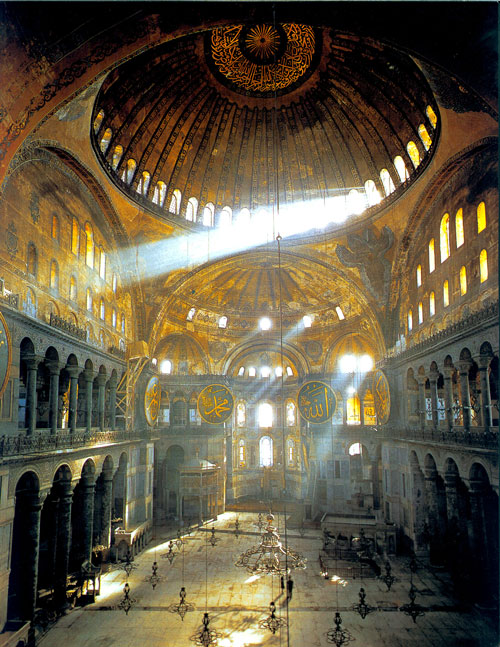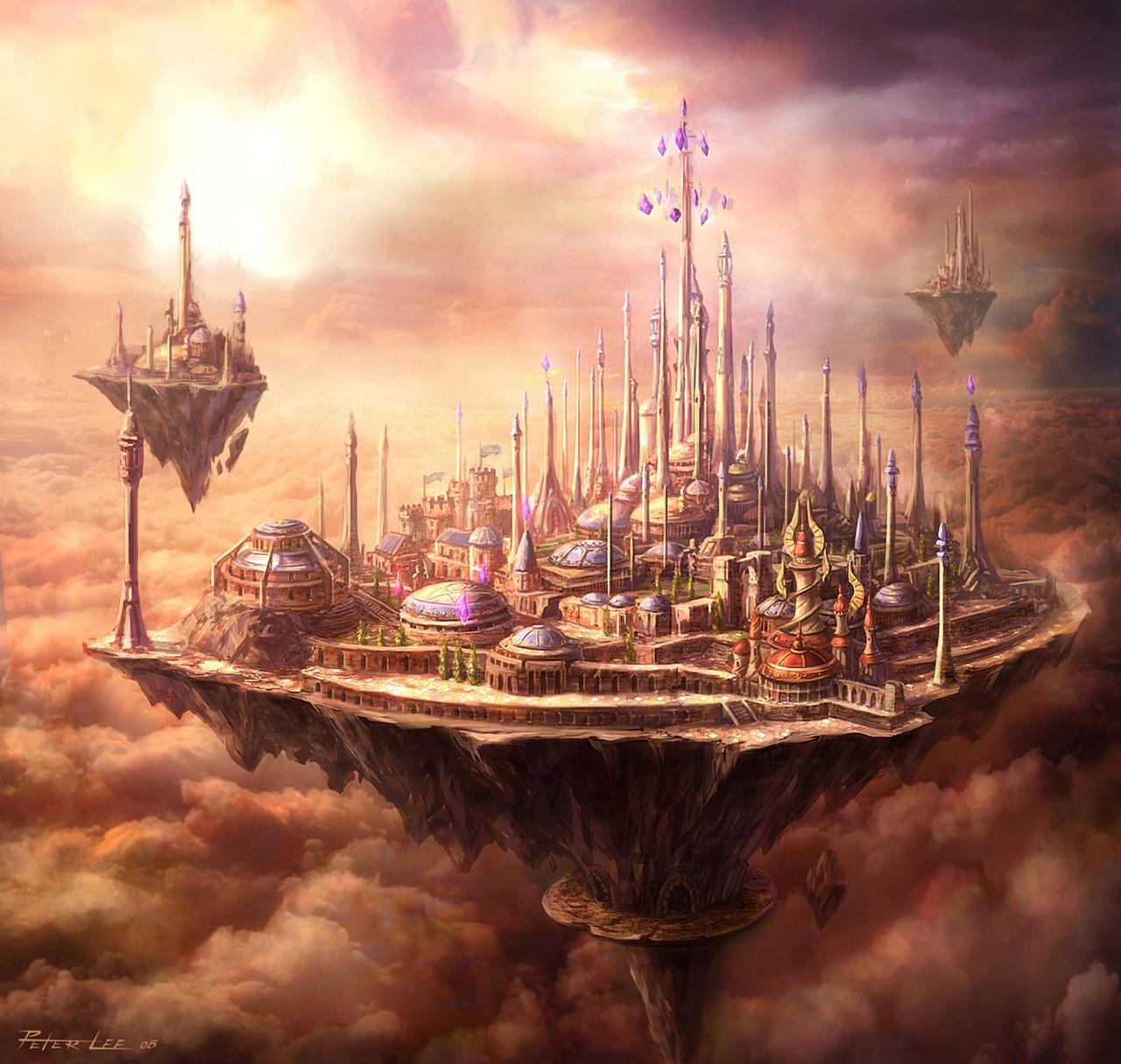
The basilica of Hagia Sophia (from the Greek “Holy Wisdom”) in Istanbul (ex Constantinople, capital of the Eastern Roman Empire) is the epitome of “the celestial in architecture.”
 The basilica was designed in 537 AD over a preexisting building by the scientist Isidore of Miletus and the mathematician Anthemius of Tralles, in obedience to Emperor Justinian’s will. The first structure -Emperor Constantius cathedral (originally called Megale Ekklesia “Great Church”)- was destroyed in 404. The second structure -re-built and dedicated in 415 by Emperor Theodosius II- burned down during a revolt in 532.
The basilica was designed in 537 AD over a preexisting building by the scientist Isidore of Miletus and the mathematician Anthemius of Tralles, in obedience to Emperor Justinian’s will. The first structure -Emperor Constantius cathedral (originally called Megale Ekklesia “Great Church”)- was destroyed in 404. The second structure -re-built and dedicated in 415 by Emperor Theodosius II- burned down during a revolt in 532.
Justinian’s Hagia Sophia was a symbol of the Emperor preeminence over the colossal Solomon’s Temple of ancient Jerusalem. <Solomon, I have outdone thee!> said the great emperor as recorded by the Byzantine scholar Procopius. The Hagia Sophia was, in fact, the greatest basilica ever built up to that time.
 The huge central dome -which is carried on four pendentives resting on a series of tympana and semi-domes of a cubic naos– “was often interpreted by contemporary commentators as the dome of heaven itself.” (Wegner)
The huge central dome -which is carried on four pendentives resting on a series of tympana and semi-domes of a cubic naos– “was often interpreted by contemporary commentators as the dome of heaven itself.” (Wegner)
The interior is decorated with marbles, precious decorative stones, and mosaics added after the interlude of Iconoclasm. The summit of the dome consists of a gold and blue colored medallion of Christ Pantocrator surrounded by a series of 40 windows which confer a blessed atmosphere to the whole environment.
The Hagia Sophia’s ceiling
 The plumb line view of this magnificent dome, makes it similar to a huge mystic eye that observe us, bringing the spectator “into direct contact with someone from another world.” (Forman) It penetrates our own space as it happens with the Sinai Christ from the Monastery of Saint Catherine of Alexandria, and other pieces of Byzantine Art. The lighting effects of the dome and the spherical blue image of the medallion -which resembles the Atlas coelestis– have been possibly influenced by the Roman Hadrian Pantheon. The Pantheon was the archetype of the orb, symbol of the cosmos and the universe as a harmonious whole, and it was associated with Jupiter. The orb -which was adapted by setting a cross above the ball to signify the world dominated by Christianity- is a persistent symbol in the whole Byzantine Art (such as in the ivory diptych of Saint Michael the Archangel).
The plumb line view of this magnificent dome, makes it similar to a huge mystic eye that observe us, bringing the spectator “into direct contact with someone from another world.” (Forman) It penetrates our own space as it happens with the Sinai Christ from the Monastery of Saint Catherine of Alexandria, and other pieces of Byzantine Art. The lighting effects of the dome and the spherical blue image of the medallion -which resembles the Atlas coelestis– have been possibly influenced by the Roman Hadrian Pantheon. The Pantheon was the archetype of the orb, symbol of the cosmos and the universe as a harmonious whole, and it was associated with Jupiter. The orb -which was adapted by setting a cross above the ball to signify the world dominated by Christianity- is a persistent symbol in the whole Byzantine Art (such as in the ivory diptych of Saint Michael the Archangel).
The Hagia Sophia in Video Games
The holiness and greatness of Hagia Sophia served as a model not only for many Ottoman mosques (such as the Blue Mosque of Istanbul), and Byzantine churches (such as the Martorana of Palermo, Italy). It also inspired contemporary scholars and artist.
 M. Hurley (Princeton class of 1997), for instance, was fascinated by the structure and created a detailed computer model of the basilica used as a tool for visualization and walkthroughs. In the videogame “Assassin’s Creed: Revelations” an incredible reconstruction of the Hagia Sophia rise in the Imperial District of Constantinople. According to the game story, the main character Ezio Auditore has to climb to the ceiling of the dome in order to activate an entrance to a secret storage room in which the “armor of Ishak Pasha” is concealed.
M. Hurley (Princeton class of 1997), for instance, was fascinated by the structure and created a detailed computer model of the basilica used as a tool for visualization and walkthroughs. In the videogame “Assassin’s Creed: Revelations” an incredible reconstruction of the Hagia Sophia rise in the Imperial District of Constantinople. According to the game story, the main character Ezio Auditore has to climb to the ceiling of the dome in order to activate an entrance to a secret storage room in which the “armor of Ishak Pasha” is concealed.
Hagia Sophia and World of Warcraft
A very similar resemblance seems to emerge also in the well-known video game World of Warcraft by Blizzard. The game features a “magocratic city-state” called Dalaran, located within a bubble shield (an orb) over a ground elevation (celestial projection). The kingdom flag is a golden eye set against a light purple background (the mystic eye).  Dalaran in characterized by Turkish structures: minarets alike turrets and domed buildings. The Violet Citadel -the central fortress of the city-state- houses the “Eye of Dalaran” a device created by the mages to focus their magics in an effort to reconstruct the Violet Citadel that was razed during the Second War (a reference to the Megale Ekklesia demolition?). Furthermore, in the interior of the Violet City the ceiling is decorated with a huge blue/purple medallion with golden ornaments and its center area consist of six golden lights.
Dalaran in characterized by Turkish structures: minarets alike turrets and domed buildings. The Violet Citadel -the central fortress of the city-state- houses the “Eye of Dalaran” a device created by the mages to focus their magics in an effort to reconstruct the Violet Citadel that was razed during the Second War (a reference to the Megale Ekklesia demolition?). Furthermore, in the interior of the Violet City the ceiling is decorated with a huge blue/purple medallion with golden ornaments and its center area consist of six golden lights.
Fortuity or not, the majesty of the Hagia Sophia remains as a symbol of supreme godliness expressed through architecture in the whole art history. Despite its different religious intents (a former Orthodox basilica since the IV Century AD turned into mosque in the XV Century AD, and now a museum), the Hagia Sophia is an eternal temple which represents both the greatness of brilliant men (such as Isidore of Miletus and Anthemius of Tralles) and the sparkling regality of Justinian who can be defined “the Hadrian of the Bizantine World.”
Work-cited
- Forman, Kevin Brent. “Art history through the 15th century.” 2013. Academy of Art University. Web. 03/27/2013. <http://www.academyart.edu>.
- Krystek, Lee. “Hagia Sophia: The Place of Holy Wisdom”. 2012. The Museum of UnNatural Mystery. Web. 03/29/2013. <http://unmuseum.org>.
- Wegner, Emma. “Hagia Sophia, 532–37”. The Metropolitan Museum of Art. Web. 03/29/2013. <http://metmuseum.org>.
- “The Hagia Sophia”. Princeton University. Web. 03/29/2013. <http://princeton.edu>.
- “Dalaran”. WOW Wiki. Web. 03/29/2013. <http://wowwiki.com>.
- “Eye of Dalaran”. —.
- “Violet Citadel”. —.
- “Hagia Sophia”. Assassin’s Creed Wiki. Web. 03/31/2013. <http://assassinscreed.wikia.com>.
- “orb”. Encyclopædia Britannica. Web. 03/29/2013. <http://britannica.com>.
- “Saint Michael the Archangel”, right leaf of a diptych. British Museum, London.
- “Sinai Christ”, from the Monastery of Saint Catherine of Alexandria, Sinai, Egypt.
- Anthemius of Tralles and Isidorus of Miletus, “Hagia Sophia”. Istanbul, Turkey.
- Sedefhar Mehmet Ağa, “Blue Mosque”. Istanbul, Turkey.
- “Church of Santa Maria dell’Ammiraglio (Martorana)”. Palermo, Italy.
Mirta Rotondo. Professor Kevin Brent Forman. LA 120 OL1. Academy of Art University (San Francisco, CA).

 Italiano
Italiano